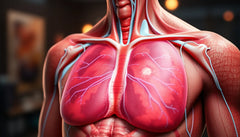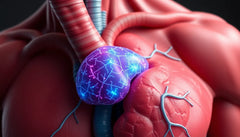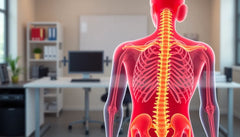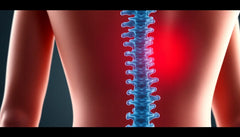Understanding herniated discs, often referred to as "slipped discs" or "herniated discs," is essential for anyone experiencing back pain or discomfort. This condition occurs when an intervertebral disc, which acts as a cushion between the bones of the spine, becomes displaced or ruptures. This displacement can lead to significant pain and discomfort, affecting one's ability to perform everyday activities.
Understanding herniated discs, often referred to as "slipped discs" or "herniated discs," is essential for anyone experiencing back pain or discomfort. This condition occurs when an intervertebral disc, which acts as a cushion between the bones of the spine, becomes displaced or ruptures. This displacement can lead to significant pain and discomfort, affecting one's ability to perform everyday activities.
The prevalence of herniated discs makes it a crucial topic for discussion. Many individuals, regardless of age or lifestyle, can be affected by this condition. It is not only a common cause of back pain but also a significant factor that impacts the quality of life. Understanding the nature of herniated discs, their causes, and potential solutions is vital for anyone looking to manage their symptoms effectively.
A herniated disc can occur in any part of the spine, but it is most commonly found in the lower back, known as the lumbar region, and the neck, or cervical region. The pain resulting from a herniated disc can be intense, often radiating to other parts of the body, such as the arms or legs, depending on the location of the disc. This can lead to a range of symptoms, including numbness, tingling, and weakness in the affected areas, which can significantly limit daily activities and overall mobility.
Given the potential impact of a herniated disc on one's life, it is important to seek timely and appropriate medical advice. Early diagnosis and intervention can help alleviate symptoms and prevent further complications. In the following sections, we will explore the causes, symptoms, and potential treatments for herniated discs, offering insights into how individuals can find relief and improve their quality of life.
importance of understanding herniated discs
The importance of understanding herniated discs cannot be overstated. With the increasing number of people experiencing back pain, often due to sedentary lifestyles, poor posture, or occupational hazards, knowledge about this condition is more relevant than ever. By gaining a clearer understanding of the anatomy and function of intervertebral discs, individuals can better appreciate the significance of maintaining spinal health and preventing disc-related issues.
Moreover, awareness of herniated discs can empower individuals to make informed decisions about their health. Recognizing the early signs and symptoms can lead to prompt intervention, potentially reducing the need for invasive treatments. Additionally, understanding the risk factors associated with herniated discs, such as age, genetics, and lifestyle choices, can help individuals adopt preventive measures to protect their spine.
In conclusion, herniated discs are a common yet often misunderstood condition that can have a profound impact on one's life. By delving into the causes, symptoms, and treatment options, individuals can take proactive steps towards managing their spinal health and improving their overall well-being. Stay tuned as we explore these aspects in greater detail, providing valuable insights and practical solutions for those affected by herniated discs.
causes of herniated discs
Herniated discs can result from a variety of factors, making it essential to understand the underlying causes to effectively manage and prevent this condition. One of the primary risk factors is aging. As we age, our intervertebral discs lose some of their water content, making them less flexible and more prone to tearing or rupturing with even minor strains or twists. This degeneration is a natural part of the aging process, but it can be exacerbated by other factors.
Repetitive movements, especially those involving heavy lifting or twisting, can also lead to a herniated disc. Individuals who work in physically demanding jobs, such as construction workers or those in manufacturing, may face a higher risk. Similarly, athletes who engage in high-impact sports or those that require repetitive motions, like weightlifting or gymnastics, are also susceptible.
In addition to physical activities, sudden injuries, such as falls or accidents, can cause immediate disc herniation. Moreover, genetic predispositions play a role; some people inherit a tendency to develop herniated discs due to the structural characteristics of their spine. Understanding these risk factors is crucial for those looking to minimize their chances of experiencing a herniated disc.
symptoms and diagnosis
The symptoms of a herniated disc can vary significantly depending on the location and severity of the herniation. Common symptoms include localized pain in the back or neck, which can radiate to the arms or legs. This pain is often accompanied by numbness or tingling in the affected areas, as well as muscle weakness. In severe cases, individuals may experience a loss of reflexes or even difficulty controlling bowel or bladder functions, indicating a medical emergency.
Diagnosing a herniated disc typically involves a combination of a physical examination and imaging tests. During the physical exam, a healthcare provider will assess the patient's range of motion, reflexes, and muscle strength. If a herniated disc is suspected, imaging tests such as an MRI (Magnetic Resonance Imaging) are often used to confirm the diagnosis. An MRI provides detailed images of the spine, allowing the doctor to see the extent of the disc herniation and determine the best course of treatment.
medical treatments
Treatment for herniated discs usually begins with non-surgical options. These may include physical therapy, which aims to strengthen the muscles around the spine, improve flexibility, and reduce pain. Physical therapists often guide patients through a series of exercises tailored to their specific condition, helping to alleviate symptoms and prevent future issues.
In addition to physical therapy, medications such as nonsteroidal anti-inflammatory drugs (NSAIDs) are commonly prescribed to reduce inflammation and relieve pain. In some cases, doctors may recommend corticosteroid injections to provide more immediate relief from severe pain and swelling.
While most herniated discs can be managed with these conservative treatments, surgery may be necessary when symptoms persist or worsen despite non-surgical interventions. Surgical options vary, but common procedures include discectomy, where the protruding portion of the disc is removed, or spinal fusion, which stabilizes the affected area of the spine. The decision to undergo surgery is typically made after careful consideration of the patient's symptoms, overall health, and lifestyle needs.
Understanding the causes, symptoms, and treatment options for herniated discs is vital for those affected by this condition. With the right knowledge and approach, individuals can take proactive steps to manage their symptoms, improve their quality of life, and prevent future occurrences. In the next section, we will explore lifestyle modifications and ergonomic solutions that can further aid in the relief and prevention of herniated discs.
solutions ergonomiques et de style de vie pour les herniated discs
Pour ceux qui souffrent de herniated discs, intégrer des solutions ergonomiques et des modifications du style de vie peut considérablement améliorer le confort et la qualité de vie. Les aides ergonomiques jouent un rôle crucial dans la gestion de cette condition. Par exemple, les chaises de bureau avec un bon soutien lombaire, les bureaux réglables en hauteur et les coussins de siège conçus pour réduire la pression sur la colonne vertébrale peuvent être bénéfiques. Anodyne propose une gamme de produits ergonomiques qui visent à soulager la pression sur la colonne vertébrale, aidant ainsi à réduire les symptômes associés aux herniated discs.
En plus des solutions ergonomiques, adopter un mode de vie sain est essentiel. Un exercice modéré, tel que la natation ou le yoga, peut aider à renforcer les muscles du dos et améliorer la flexibilité. Cela contribue à stabiliser la colonne vertébrale et à prévenir de futures blessures. Maintenir un poids sain est également crucial, car un excès de poids exerce une pression supplémentaire sur les disques intervertébraux, augmentant le risque de herniation.
Une attention particulière à l'ergonomie au travail est également recommandée. Assurez-vous que votre espace de travail est configuré pour soutenir une bonne posture. Cela inclut le réglage de la hauteur de votre écran d'ordinateur pour qu'il soit à hauteur des yeux et l'utilisation d'un clavier et d'une souris ergonomiques pour réduire la tension sur le dos et le cou. Prendre des pauses régulières pour s'étirer et bouger peut également prévenir la raideur et les douleurs associées à une position assise prolongée.
questions fréquemment posées
Qu'est-ce qu'une hernie discale ?
Une hernie discale, souvent appelée "slipped disc" ou "herniated disc", est une condition où un disque intervertébral se déplace de sa position normale, provoquant douleur et inconfort.
Quels sont les premiers signes d'une hernie discale ?
Les premiers signes incluent généralement une douleur intense dans le dos ou le cou, souvent accompagnée d'engourdissement ou de faiblesse dans les membres.
Est-il possible de prévenir une hernie discale ?
Bien que toutes les hernies discales ne puissent être évitées, le maintien d'une bonne posture, l'exercice régulier et l'utilisation d'aides ergonomiques peuvent réduire le risque.
Quand dois-je consulter un médecin pour une hernie discale ?
Si la douleur persiste malgré les traitements à domicile ou s'accompagne de faiblesse ou d'engourdissement, il est important de consulter un professionnel de santé.
Quels sont les traitements les plus efficaces pour une hernie discale ?
Les traitements varient selon la gravité, mais incluent souvent la physiothérapie, les médicaments, et dans certains cas, la chirurgie.
En conclusion, comprendre les herniated discs et les solutions disponibles peut grandement aider ceux qui en souffrent à gérer leurs symptômes et à améliorer leur qualité de vie. En adoptant des solutions ergonomiques et en faisant des ajustements de style de vie, il est possible de soulager la pression sur la colonne vertébrale et de prévenir de futures complications. Pour plus d'informations sur les produits ergonomiques, consultez les offres d'Anodyne qui visent à soutenir la santé de votre colonne vertébrale.





















